November 28th 1489 Margaret Stewart born (nee Margaret Tudor , (Douglas)) Princess of England, Queen Dowager of Scots.
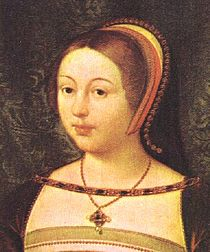 November 28 1489 Margaret Stewart born (nee Margaret Tudor , (Douglas)) Princess of England, Queen Dowager of Scots died 1541
November 28 1489 Margaret Stewart born (nee Margaret Tudor , (Douglas)) Princess of England, Queen Dowager of Scots died 1541
Margaret Tudor (28 November 1489 – 18 October 1541) was the elder of the two surviving daughters of Henry 7th King of England and Elizabeth of York, and the elder sister of Henry 8th. In 1503, she married James 4th, King of Scots, one child James 5th, widowed 10 years later in 1513, married Earl of Angus, one child Margaret, divorced, married Henry Stewart, who was made Lord Methven between 1521 and 1525, one child Master of Methven.
1578 RUTHVEN, WILLIAM, 4th Lord Ruthven and 1st Earl of Gowrie (1541?–1584), Provost and Lieutenant of Perth, lord high treasurer, appointed an extraordinary lord of session.
1601 Barony of Calderwood infected and shut up. pp. 370 November 28. A History of Epidemics in Britain from A.D. 664 to the Extinction of Plague Charles Creighton, M.A. M.D. Demonstrator of Anatomy University of Cambridge. 1891
1660 the formation of a “College for the Promoting of Physico-Mathematical Experimental Learning”. Becomes the Royal Society.
1666 – At least 3000 men of the Scottish Royal Army led by Tam Dalyell of the Binns defeat about 900 Covenanter rebels in the Battle of Rullion Green.
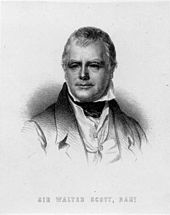 1825 Sir Walter Scott used the phrase “Pretty Fanny’s Way”, attributed to the Graveyard poet Thomas Parnell, Per Scott, ‘[John Gibson] Lockhart must be liked where his good qualities are known, and where his fund of information has room to be displayed. But, notwithstanding a handsome exterior and face, I am not sure he will succeed in London Society; he sometimes reverses the proverb, and gives the volte strette e pensiere sciolti, withdraws his attention from the company, or attaches himself to some individual, gets into a corner, and seems to be quizzing the rest. This is the want of early habits of being in society, and a life led much at college. In London it is of less consequence whether he please in general society or not, since if he can establish himself as a genius it will only be called “Pretty Fanny’s Way.” [eccentric]
1825 Sir Walter Scott used the phrase “Pretty Fanny’s Way”, attributed to the Graveyard poet Thomas Parnell, Per Scott, ‘[John Gibson] Lockhart must be liked where his good qualities are known, and where his fund of information has room to be displayed. But, notwithstanding a handsome exterior and face, I am not sure he will succeed in London Society; he sometimes reverses the proverb, and gives the volte strette e pensiere sciolti, withdraws his attention from the company, or attaches himself to some individual, gets into a corner, and seems to be quizzing the rest. This is the want of early habits of being in society, and a life led much at college. In London it is of less consequence whether he please in general society or not, since if he can establish himself as a genius it will only be called “Pretty Fanny’s Way.” [eccentric]
Sir Walter Scott. In 1877 Seventeen Eminent Scots’ Spirits, including Sir Walter, appeared to and requested Baptism from Wilford Woodruff, President of the Saint George Temple, WASHINGTON, Utah 22-23 August 1877. Woodruff’s eminent men – Scots
Lockhart of Bar 1297 2Miller 2Simmons 2Choate 2Sorensen
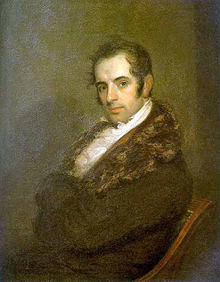 1859 Washington Irving (April 3, 1783 – November 28, 1859 Tarrytown, New York.) was an American author, essayist, biographer, historian, and diplomat of the early 19th century. Irving is best known for his short stories “The Legend of Sleepy Hollow” and “Rip Van Winkle”, in The Sketch Book of Geoffrey Crayon, Gent. Irving’s wrote biographies of George Washington, Oliver Goldsmith, Muhammad, and histories of 15th -century Spain and Christopher Columbus, the Moors, and the Alhambra. Irving served as the U.S. ambassador to Spain from 1842 to 1846. Washington Irving’s parents were William Irving, Sr., originally of Quholm, Shapinsay, Orkney [Islands Scotland], and Sarah (née Sanders), married in 1761 while William was serving as a petty officer in the British Navy. William and Sarah had eleven children, eight survived to adults: William, Jr. (1766), Ann (1770), Peter (1772), Catherine (1774), Ebenezer (1776), John Treat (1778), Sarah (1780), and Washington.
1859 Washington Irving (April 3, 1783 – November 28, 1859 Tarrytown, New York.) was an American author, essayist, biographer, historian, and diplomat of the early 19th century. Irving is best known for his short stories “The Legend of Sleepy Hollow” and “Rip Van Winkle”, in The Sketch Book of Geoffrey Crayon, Gent. Irving’s wrote biographies of George Washington, Oliver Goldsmith, Muhammad, and histories of 15th -century Spain and Christopher Columbus, the Moors, and the Alhambra. Irving served as the U.S. ambassador to Spain from 1842 to 1846. Washington Irving’s parents were William Irving, Sr., originally of Quholm, Shapinsay, Orkney [Islands Scotland], and Sarah (née Sanders), married in 1761 while William was serving as a petty officer in the British Navy. William and Sarah had eleven children, eight survived to adults: William, Jr. (1766), Ann (1770), Peter (1772), Catherine (1774), Ebenezer (1776), John Treat (1778), Sarah (1780), and Washington.
The Irving family settled in Manhattan, New York City, and was part of the city’s merchant class when Washington Irving was born on April 3, 1783, the same week city residents learned of the British ceasefire that ended the American War for independence. Mother Sarah mother named him after her hero, George Washington. At age six, Irving met President Washington, who was then living in New York after his inauguration in 1789. The president blessed young Irving, an encounter Irving later commemorated in a small watercolor painting, which still hangs in his home today (whatever day this is). The Irvings lived at 131 William Street at the time of Washington Irving’s birth. The family later moved across the street to 128 William St.
Portrait of Washington Irving by John Wesley Jarvis, from 1809. In 1877 Seventeen Eminent Scots’ Spirits (among others) appeared to and requested Baptism from Wilford Woodruff, President of the Saint George Temple, WASHINGTON, Utah 22-23 August 1877. Woodruff’s eminent men – Scots. Included were Irving and George Washington.
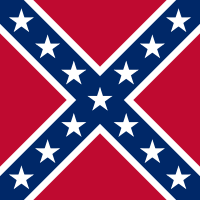 1861 Confederate Battle Flag. The flag of Scotland features St Andrew’s saltire cross. On November 28, 1861, Confederate soldiers in the Army of Northern Virginia received the new battle flags in ceremonies at Centreville and Manassas, Virginia, and carried them throughout the Civil War. Beauregard gave a speech encouraging the soldiers to treat this new flag with honor and that it must never be surrendered. Many soldiers wrote home about the ceremony and the impression the flag had upon them, the “fighting colors” boosting morale after the confusion at the Battle of First Manassas. The battle flag only grew in its identification with the Confederacy and the South in general. Later, a 13th star was added for Kentucky.
1861 Confederate Battle Flag. The flag of Scotland features St Andrew’s saltire cross. On November 28, 1861, Confederate soldiers in the Army of Northern Virginia received the new battle flags in ceremonies at Centreville and Manassas, Virginia, and carried them throughout the Civil War. Beauregard gave a speech encouraging the soldiers to treat this new flag with honor and that it must never be surrendered. Many soldiers wrote home about the ceremony and the impression the flag had upon them, the “fighting colors” boosting morale after the confusion at the Battle of First Manassas. The battle flag only grew in its identification with the Confederacy and the South in general. Later, a 13th star was added for Kentucky.
The Battle Flag of the Confederacy, with the Scot’s cross of Saint Andrew.
1889 Utah Territory. John Lyon died, poet. John Lyon born Glasgow, Lanarkshire, Scotland. John’s 3rd great grand-daughter Melodie Lyon Henderson is the choir director in the Arlington 1st Ward, McLean Virginia Stake in 2012.
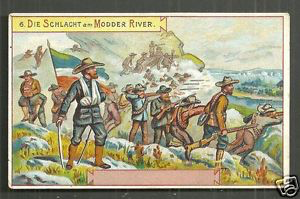 1899 The Battle of Modder River. The Boer War. In the North West of Cape Colony near the border with the Orange Free State in South Africa. Highland regiments in Natal devised aprons to conceal coloured kilts and sporrans. 1st Highland Light Infantry
2nd Seaforth Highlanders
1st Argyll and Sutherland Highlanders. 1st and 2nd Coldstream Guards.
1st Scots Guards.
2nd Black Watch. 1st Argyll and Sutherland Highlanders, inched forward; the infantry attack supported by the fire of the 62nd Battery, Royal Field Artillery, and finally rushed the ford, pushing the Free Staters back across the river. The brigade commander, General Colville, called the Coldstream back from moving too far along the bank, preventing them from discovering the main ford which lay to the east of the railway bridge.
1899 The Battle of Modder River. The Boer War. In the North West of Cape Colony near the border with the Orange Free State in South Africa. Highland regiments in Natal devised aprons to conceal coloured kilts and sporrans. 1st Highland Light Infantry
2nd Seaforth Highlanders
1st Argyll and Sutherland Highlanders. 1st and 2nd Coldstream Guards.
1st Scots Guards.
2nd Black Watch. 1st Argyll and Sutherland Highlanders, inched forward; the infantry attack supported by the fire of the 62nd Battery, Royal Field Artillery, and finally rushed the ford, pushing the Free Staters back across the river. The brigade commander, General Colville, called the Coldstream back from moving too far along the bank, preventing them from discovering the main ford which lay to the east of the railway bridge.
- Colville of Easter Wemyss 1132 2Semple2Montgomery 2Cochrane2Miller 2Simmons2Choate zoe ToaG
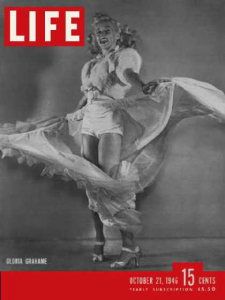 1928 ‘Gloria Grahame’ stage name for Gloria Clements Howard Ray (nee Hallward) born in Los Angeles (died 1981). Clan McDougall thru her mother Jeanne Hallward (nee McDougall). Gloria was nominated for the Academy Award for best supporting actress (1947) for Crossfire, and won for The Bad and the Beautiful (1952). She was Violet Bick in It’s a Wonderful Life (1946), the classic Christmas movie of Jimmy Stewart (clan Stewart) as (fictional) George Bailey trying to sort out a life without a life.
1928 ‘Gloria Grahame’ stage name for Gloria Clements Howard Ray (nee Hallward) born in Los Angeles (died 1981). Clan McDougall thru her mother Jeanne Hallward (nee McDougall). Gloria was nominated for the Academy Award for best supporting actress (1947) for Crossfire, and won for The Bad and the Beautiful (1952). She was Violet Bick in It’s a Wonderful Life (1946), the classic Christmas movie of Jimmy Stewart (clan Stewart) as (fictional) George Bailey trying to sort out a life without a life.
Gloria Hallward (clan MacDougall) featured on the cover of Life in the promotional run up for the release of It’s a Wonderful Life November 1946. The magazine is two days before Gretchen Luther‘s (clan Armstrong, MacPherson, Fraser) debut.
1939 Edna Beth Choate (nee Petersen) born.
2003 Anne Elizabeth Grace Choate born, many great granddaughter of Margaret Stewart (nee Tudor, Douglas). Anne’s Clans (Clans Martin, Maule, Maxwell, Meldrum, Melville, Menteith, Menzies, Montgomerie, Mortimer, Morton, Mure, Murray)
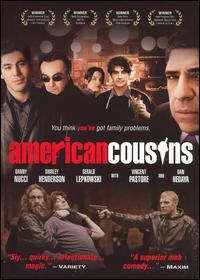 2003 American Cousins Filmed in Scotland. A romantic comedy about a Scots-Italian fish and chip shop owner who gives refuge to his Mafia relatives when they go on the run. It was voted one of the top three Scottish films of all time by readers of The List magazine
2003 American Cousins Filmed in Scotland. A romantic comedy about a Scots-Italian fish and chip shop owner who gives refuge to his Mafia relatives when they go on the run. It was voted one of the top three Scottish films of all time by readers of The List magazine
Cover. New Jersey dealers take refuge with their law-abiding cousin Bobby, who runs a fish and chip shop in Glasgow, Scotland.
Disclaimer: The author of each article published on this web site owns his or her own words. The opinions, beliefs and viewpoints expressed by the various authors and forum participants on this site do not necessarily reflect the opinions, beliefs and viewpoints of Utah Standard News or official policies of the USN and may actually reflect positions that USN actively opposes. No claim in public domain or fair use. © John Choate
Utah Standard News depends on the support of readers like you.
Good Journalism requires time, expertise, passion and money. We know you appreciate the coverage here. Please help us to continue as an alternative news website by becoming a subscriber or making a donation. To learn more about our subscription options or make a donation, click here.
To Advertise on UtahStandardNews.com, please contact us at: ed@utahstandardnews.com.


Comments - No Responses to “November 28th 1489 Margaret Stewart born (nee Margaret Tudor , (Douglas)) Princess of England, Queen Dowager of Scots.”
Sure is empty down here...